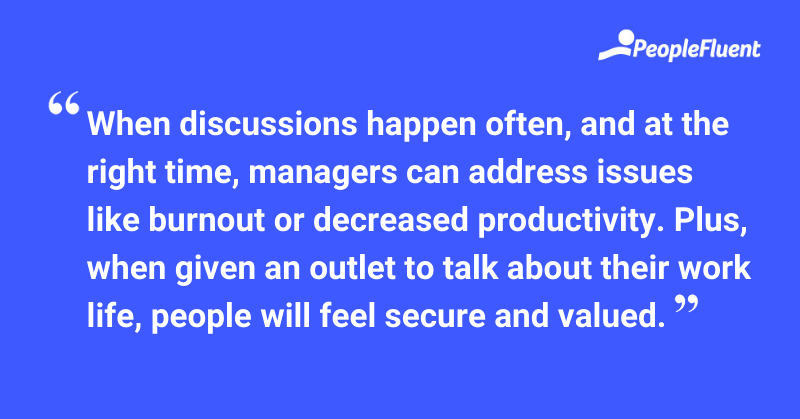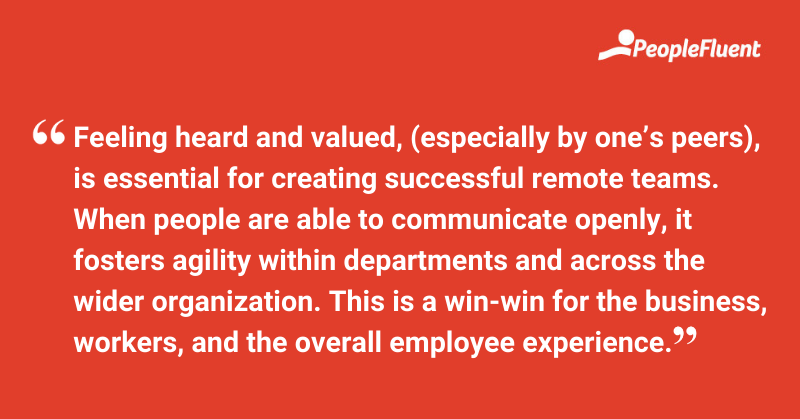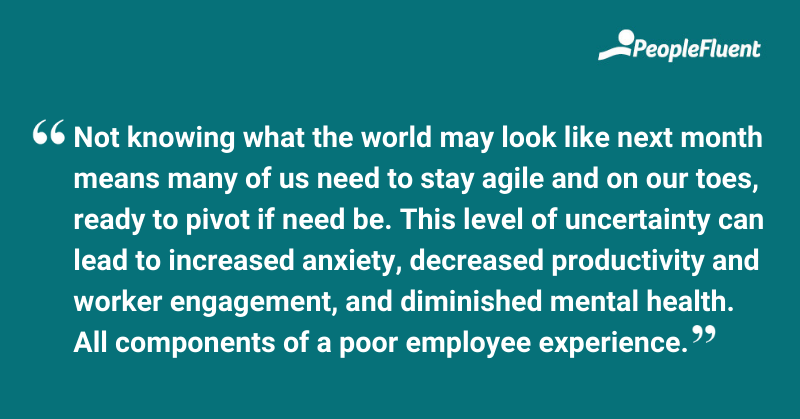Is your workforce one of the many across the globe that’s facing labor shortages, reskilling and upskilling challenges, and a total shift in how we work? If that sounds like you, it’s time you looked at a talent mobility tool to help you and your people navigate a new employee experience.
How your employees feel about your company should make them want to stay, grow, and succeed at your organization.
But, when you reflect on the journey people go through to build a career, there are many hurdles that aren’t always easy to overcome. Naturally, that gives way to the normal human emotions that we all feel when we experience wins or losses. And, as organizations reimagine today’s talent journey, they should be focused on creating a better employee experience.
Let’s look at the four ways talent mobility can help you create a winning employee experience at your company.
1) Identify—And Fix!—Gaps in Employee Morale
First and foremost, employees need to feel supported and valued. Without this focus, employers will experience turnover and be less attractive to top talent—not a good look while we learn to navigate a tighter, more competitive labor market.
A lot of these challenges can be solved by recognizing when employee morale may be low across the whole organization. It’s always a good time to think about how your team is experiencing the work environment. It takes more than just day-to-day tasks and responsibilities to create an employee experience that people are happy with. It requires a close look at every aspect of what they do on the job, including:
- Organizational culture
- Communication style and frequency
- Compensation structure
- Total rewards package
- The onboarding process and ongoing feedback
- Professional development opportunities
If one or more of these factors is contributing to low employee engagement or morale, it’s time to start looking into solutions. When employees genuinely enjoy coming to work (or logging into work remotely!), they’re more motivated to be productive and efficient. High morale also means a higher quality of work and your employees will feel fulfilled by their contributions to the company.
KEEP READING | ‘Working Together: How Talent Mobility Influences Employee Experience (And Vice Versa)’
2) Encourage Open Communication With Managers
So, what should be at the heart of every talent strategy? For starters, the ability to connect top performers to opportunities that build their skills and put them in the best position to energize and challenge them. But how can employers make that journey a smoother experience?
While technology can be a big part of helping you and your people, it’s not a catch-all. The right HR tech can, however, help you fill gaps that might lead to a poor employee experience. All of this begins with open communication between individuals and their managers.
Bosses staying in contact with their employees might seem like a no-brainer, but it doesn’t mean it always happens. According to an internal report by the Brandon Hall Group, only 20% of organizations say their managers consistently provide helpful feedback and coaching to their employees, but those that do are 85% more likely to see a year-over-year increase in talent retention.
When discussions happen often, and at the right time, managers can address issues like burnout or decreased productivity. Plus, when given an outlet to talk about their work life, people will feel secure and valued. This same concept can be applied to opening lines of communication between work peers, even if they’re not on the same teams.

MORE FROM THE BLOG | ‘Upskilling vs. Reskilling: Understanding the Differences and Their Role in Talent Mobility’
3) Create Opportunities for Formal and Informal Collaboration
At some point in the last 18+ months since the pandemic started, most of us have struggled to stay productive and connected while we’ve been physically disconnected from our workmates and offices. It’s important to book in time for chats with colleagues—even if it’s just a few times a month. Managers can be proactive here by encouraging people to have informal conversations while working remotely.
Cross-collaboration is a great way to enhance business outcomes and lead to career growth by way of mentorship—a great strategy for helping remote workers connect with peers and share knowledge across the business. Consider this: line and department managers are people like the rest of us. While they’ve become integral to keeping teams functioning (and also providing timely feedback to higher-ups in the business), they’re not available 24/7. When employees have other points of contact, such as a mentor, they don’t feel as isolated or without answers to pressing questions.
In the case of global teams working across timezones, a mentor may be local and able to respond quicker in times of need. Just because we’re mostly working hybrid schedules or from home—and are spread across multiple locations—doesn’t mean we can’t create feedback loops that provide more than operational support. Being able to run an idea by someone, or simply stop in for a virtual “coffee talk”, goes a long way when someone’s feeling isolated.
Feeling heard and valued, (especially by one’s peers), is essential for creating successful remote teams. When people are able to communicate openly, it fosters agility within departments and across the wider organization. This is a win-win for the business, workers, and the overall employee experience.

RELATED READING | ‘Growing Skills & Retaining People: How to Successfully Mentor in the Workplace’
4) Offer Flexibility for an Improved Work/Life Balance
Your employees are the backbone of your business. They’re responsible for everything from customer service to production and distribution, so it’s important that they’re happy in their role—both individually and as a team. One way you can help create an environment where people want to work is by giving the flexibility needed to create a good work/life balance. And, it may just benefit us all to make that practice a habit. Based on a study examining the importance of work flexibility for wellbeing, the U.S. National Library of Medicine found that:
- Working from home increased the likelihood of job satisfaction by 65%
- Taking time off decreased the likelihood of job stress by 56% and more than doubled the likelihood of job satisfaction
- Changing one’s schedule decreased the likelihood of job stress by 20% and increased the likelihood of job satisfaction by 62%
They may be onto something, too. Another recent publication noted that our brains simply aren’t built for the unprecedented levels of uncertainty we’ve been exposed to—for an indeterminate amount of time. After all, not knowing what the world may look like next month means many of us need to stay agile and on our toes, ready to pivot if need be. This level of uncertainty can lead to increased anxiety, decreased productivity and worker engagement, and diminished mental health. All components of a poor employee experience.
How can businesses expect workers to plan for the next quarter—much less a few weeks in advance—when the global workforce is in flux? With that, the flexibility HR and business leaders extend to their people should focus on a few core things. Those are, in no order of importance:
- Leadership’s willingness to adapt to how and when work gets done, with discretion to the project’s urgency in mind
- A culture of open communication that fosters employee feedback and puts people in charge of creating their work/life balance
- A focus on bandwidth and coverage to ensure teams across the business have the necessary resources to meet deadlines and goals

YOU MIGHT ALSO LIKE | ‘5 Things HR Pros Can Do to Ensure a Modern Talent Journey’
Give Your Employees What They Want
Technology influences so much of a worker’s experience with your company. Especially nowadays, as a majority of our time is spent in front of screens. But it usually isn’t the tech that makes for a memorable experience. Your employees will recall the skills and growth they developed at your organization just as much as they’ll remember the relationships they foster with clients, coworkers, and leadership.
As early and often as possible, create opportunities for meaningful conversations about where your employees see themselves in the organization. The sooner you help people feel connected to the work they do at your company, the more they’ll want to contribute and engage.



